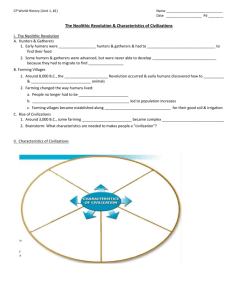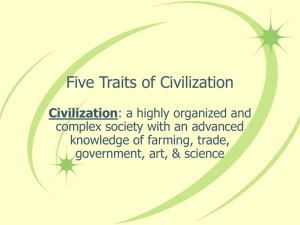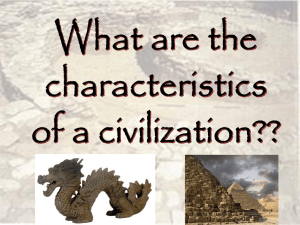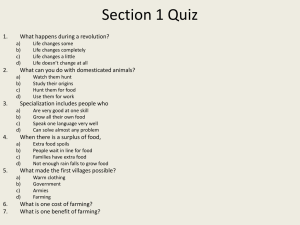AFRICA: Africa`s First People Chapt 20, Sect 1 How did early
advertisement
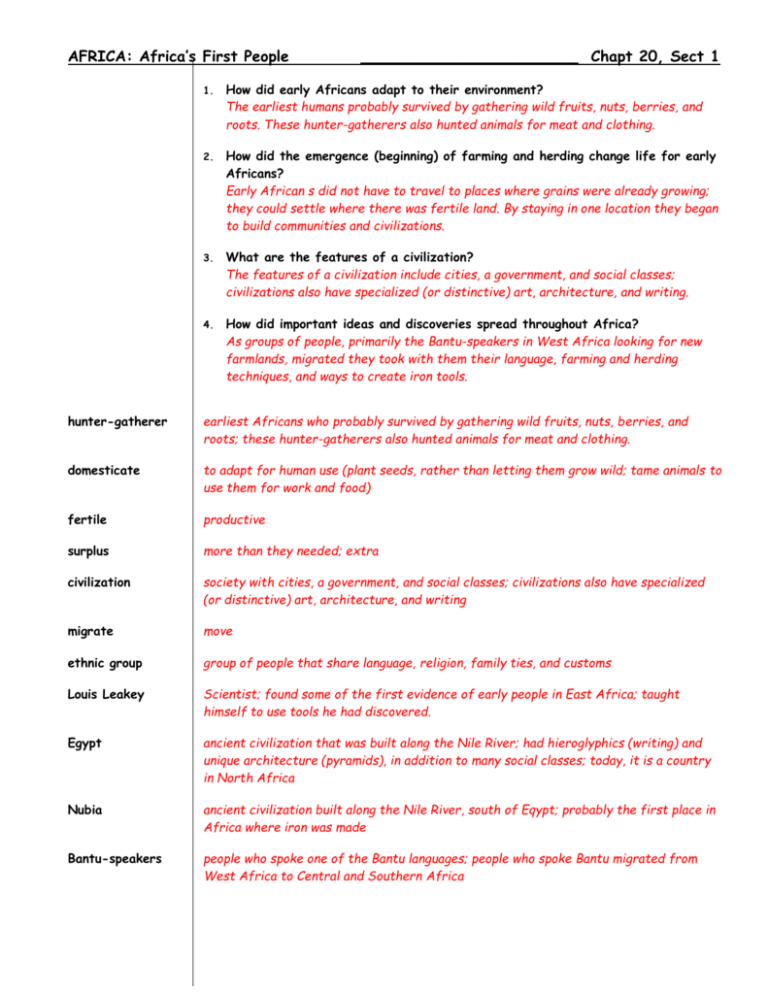
AFRICA: Africa’s First People _______________________ Chapt 20, Sect 1 1. How did early Africans adapt to their environment? The earliest humans probably survived by gathering wild fruits, nuts, berries, and roots. These hunter-gatherers also hunted animals for meat and clothing. 2. How did the emergence (beginning) of farming and herding change life for early Africans? Early African s did not have to travel to places where grains were already growing; they could settle where there was fertile land. By staying in one location they began to build communities and civilizations. 3. What are the features of a civilization? The features of a civilization include cities, a government, and social classes; civilizations also have specialized (or distinctive) art, architecture, and writing. 4. How did important ideas and discoveries spread throughout Africa? As groups of people, primarily the Bantu-speakers in West Africa looking for new farmlands, migrated they took with them their language, farming and herding techniques, and ways to create iron tools. hunter-gatherer earliest Africans who probably survived by gathering wild fruits, nuts, berries, and roots; these hunter-gatherers also hunted animals for meat and clothing. domesticate to adapt for human use (plant seeds, rather than letting them grow wild; tame animals to use them for work and food) fertile productive surplus more than they needed; extra civilization society with cities, a government, and social classes; civilizations also have specialized (or distinctive) art, architecture, and writing migrate move ethnic group group of people that share language, religion, family ties, and customs Louis Leakey Scientist; found some of the first evidence of early people in East Africa; taught himself to use tools he had discovered. Egypt ancient civilization that was built along the Nile River; had hieroglyphics (writing) and unique architecture (pyramids), in addition to many social classes; today, it is a country in North Africa Nubia ancient civilization built along the Nile River, south of Eqypt; probably the first place in Africa where iron was made Bantu-speakers people who spoke one of the Bantu languages; people who spoke Bantu migrated from West Africa to Central and Southern Africa AFRICA: Africa’s First People _______________________ Chapt 20, Sect 1 NOTE TAKING Stone Age Farmers The first use of stone tools by early huntergatherers marks the beginning of an a period scientists call the Stone Age. At first, gatherers just protected the areas where wild grains grew naturally; later they began to save some see to plant in fertile areas for the next year. Nile Civilizations Egypt began about 5000 BC. South of Egypt and beginning about 6000 BC, Nubia also began as farming villages along the Nile River. Nuggets: First people on the African continent lived in East Africa. We know this from the stones and bones they left behind. Until 4000 years ago, most of North Africa (which is now the Sahara Desert) was through to hold enough water to support many people and animals. Scientists think that farmers lived there. Paintings on cave walls tell their story. Africa’s first farmers probably lived in Algeria. Thousands of years ago more rain fell in this area, but today it is known as “the Thirst Zone.” (People need to drink about 2.5 quarts of water per day; they also need water for cooking, farming, and for their animals – about 21 quarts total per day; however, there are only about five quarts of water per person per day – ¼ amount needed – in the Thirst Zone.) The first farmers used only tools they could make by hand from stones. Farmers producing a surplus (more than they needed) allowed others in the community to do work other than farming. Social classes form when people do a variety of jobs. Each summer flooding on the Nile River left a layer of fertile, alluvial soil that was ideal for farming, Farming villages grew up along the Nile River, and as they grew they became a civilization. Ancient Egypt was ruled by kings and queens called Pharaohs; people believed them to gods as well as kings. When they died, Pharaohs were buried in pyramids. Egyptian civilizations included: pyramids; hieroglyphics; and were advanced in papermaking, architecture, medicine, and mathematics. Meroe was the name of the greatest Nubian kingdom; probably the first place where iron was made. At first, Egypt ruled Nubia, but later Nubia conquered much of Egypt. About 500 BC West African learned to heat and shape iron, using it to form tools, arrow heads, ax heads, and hoe blades. This strong iron tools made farming easier and created food surpluses. As a result, West Africa’s population increased. About 2000 years ago Bantu-speakers in West Africa began looking for additional farms lands in Central and Southern Africa. They took with them their language and knowledge of iron-making. Most of the ethnic groups in Central and Southern Africa speak Bantu languages. _____________________________________________________________________________ SUMMARY: Africa’s first peoples survived by developing tools and techniques for farming and herding, and they spread out and settled into societies.
